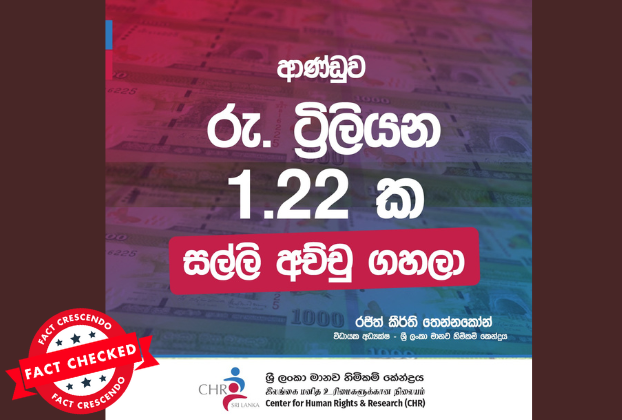Subscribe to our WhatsApp Channel
Knowingly or unknowingly, the data presented by certain political figures to criticize the government is sometimes inaccurate. As a result, society is easily misled by it. This is a fact-check we conducted to verify a report published stating that the government has printed Rs. 1.22 trillion in currency.
Social Media Posts :
Rajitha Keerthi Tennakoon, Executive Director of the Centre for Human Rights and Research, had published a social media post stating, “The government has printed Rs. 1.22 trillion in money”.
In the published official statement, he states that from October 2024 to June 2025, the Central Bank of Sri Lanka has printed 1225.9 billion rupees, which is Rs. 1.2 trillion. He describes that printing money in violation of agreements with the International Monetary Fund could be the beginning of the country heading towards another economic crisis.
Contrary to the guidelines of the International Monetary Fund, the Central Bank printed Rs. 210.3 billion (an expansion of 10.4%) in June 2025 alone. In March 2025, Rs. 233.90 billion was printed (M2b), which is the highest amount printed in a single month in the first half of the year. The economy was devastated by the unlimited money printing during the presidency of Gotabaya (The April-May 2022 inflation rate was 17% – 20%). It also states that it is the joint responsibility of Parliament and the Central Bank to take appropriate steps to prevent a financial crisis in the country.
Here is how it was widely shared across Facebook.
Fact – Check :
The facts listed in the above social media post were confirmed to be accurate, after examining the relevant reports of the Central Bank data, especially regarding money supply, credit level and gross foreign reserves.
According to data from the Trading Economics website, reserves increased from US$6,080 million in June to US$6,144 million (US$6.144 billion) in July.
Economynext reported a decline of US$206 million in June, coinciding with the change from 6.531 to 6.080.
The World Bank had confirmed the reserve value in March, stating that gross reserves were US$6.5 billion by the end of March 2025.
However, recently, the Executive Director of the Sri Lankan Centre for Human Rights and Research, Rajitha Keerthi Tennakoon, stated that 1.225 trillion rupees had been printed. Through this, it was reported that the Central Bank had printed currency.
Here, it is essential to clarify that money printing is defined as the expansion of the broad money supply (money printing- Broad money (M2b)) and not the printing of money by a machine.
Money Printing and Broad Money (M2b)
The general meaning of money printing is the central bank issuing new money into the economy. In economics, this is known as reserve money. However, many people misunderstand this as printing money.
The printing and issuance of new currency, primarily to cover government expenses, has been common in recent years, leading to inflation and currency devaluation in the country.
The crisis peaked in 2022, when Sri Lanka faced its worst financial crisis in decades, with inflation reaching an annualized rate of 49.72%. This was mainly due to
• Excessive money creation to fund government operations
• Currency devaluation that makes imports more expensive
• Supply chain disruptions that reduce the availability of goods
• Lack of confidence in money and monetary policy
However, since Sri Lanka entered the International Monetary Fund (IMF) Extended Fund Facility (EFF) program in 2023, the Central Bank of Sri Lanka has been committed to refraining from financing the fiscal deficit. The Central Bank of Sri Lanka clearly states that it has stopped printing money to finance the government’s budget deficit under the IMF Extended Fund Facility.
Instead, liquidity operations are carried out through market-based tools such as repurchase agreements, reverse repurchase agreements, and open market operations. That is, money is not simply printed with the help of a money-printing machine and released into the economic market.
According to the independent analysis by the First Capital Monthly Economic Watch – August 2025 report, the growth in broad money supply (M2b) has increased money flow through credit expansion and external inflows, and that inflation is within target levels. Inflation should rise if there is excessive money printing.
Inflation rates in the past
2024 April 1.5%
2024 June 1.7%
2024 August 0.5%
2025 June -0.6%
2025 July –0.3%
Thus, it is clear that if 1.22 trillion rupees had been printed, inflation should have increased significantly, but instead it is low or negative.
Inflation has consistently remained below the Central Bank’s 5% target, reflecting responsible monetary policy.
The Central Bank of Sri Lanka Monetary Policy Report, August 2025, further confirms that the Central Bank is refraining from printing money. Broad money supply (M2b) growth is driven by private sector credit + net foreign assets. Liquidity management was carried out not through money printing, but through repurchase agreements, reverse repurchase agreements, and open market operations.
The reports further emphasize that the current economic growth reflects not new money printing but debt to the private sector and net foreign assets.
Broad money supply (M2b) is the currency held by the public, including demand deposits, time and savings deposits with commercial banks.
Its growth reflects a mix of the following factors.
- Private sector credit expansion
- Foreign reserve building
- Government securities market activity
Thus, growth in M2b is not the same as “printing new money”.
In Sri Lanka, M2b is the most widely used measure of money supply, and changes in M2b reflect the liquidity of the economy. More information on this can be found here.
However, as Rajitha Keerthi points out in the above note, the expansion of broad money supply (M2b) is shown as Rs. 1.22 trillion. But according to the Central Bank reports, from October 2024 to May 2025, broad money supply (M2b) has grown from approximately Rs. 14.0 trillion to almost Rs. 15.0 trillion. This represents an increase of about Rs. 956.5 billion in these few months. Central Bank reports published in this regard are here and here.
Accordingly, it can be seen that the monthly data he had presented is also not correct according to the Central Bank reports. According to the Central Bank reports, the data is as follows.
CBSL Reported M2b Figures (Rs. Million)
2024 October: Rs. 14,009 million
2024 November: Rs. 14,087 million
2024 December: Rs. 14,322 million
2025 January: Rs. 14,439 million
2025 February: Rs. 14,544 million
Monthly Economic Indicators (MEI):
End of April 2025: Rs. 14,931.9 million
End of May 2025: Rs. 14,965.5 million
2024 October: Rs. 14,009 million
2024 November: Rs. 14,087 million
2024 December: Rs. 14,322 million
2025 January: Rs. 14,439 million
2025 February: Rs. 14,544 million
2025 April: Rs. 14,931.9 million
2025 May: Rs. 14,965.5 million
However, he cited that the reason for this expansion of the broad money supply is the printing of money. Though he interpreted broad money supply as money printing, he stated that the International Monetary Fund has banned money printing in this country. Through that, it is clear that he has confused the money printing and broad money supply.
Broad money (M2b) increased by Rs. 1.22 trillion
Although the above chart states that broad money (M2b) expanded by approximately Rs. 1.22 trillion from October 2024 to June 2025, the data is not accurate. According to Central Bank reports, nearly Rs. 15.0 trillion has been expanded during that period, and this does not automatically equate to “money printing”.
Broad money expansion can occur through:
- Growth in bank credit (banks providing more loans to businesses and housholds)
- Increase in deposists (savings, demand, time deposits)
- Foreign inflows (remittances, exports, Foreign Direct Investment (FDI))
- Central bank actions (expansion of reserve money, i.e. “printing” real money)
In 2025, despite the broad money supply expansion, inflation, which was –0.3% in July 2025, is still negative, further confirming that no money printing has taken place. If money is being printed, inflation should increase. It is further clear that the increase in the broad money supply is not due to excessive “money printing” but instead to credit and deposit-based growth.
IMF recommendation
One of the strict conditions of Sri Lanka’s IMF Extended Fund Facility (EFF) program was that the Central Bank should not print money to finance government deficits directly.
Does “no printing” mean “no broad money supply (M2b) growth”?
No. The International Monetary Fund (IMF) does not prohibit broad money supply (M2b) growth. The broad money supply is expected to grow in a recovering economy, as people save, borrow, and deposit more.
The IMF prohibits excessive reserve expansion and printing money to cover deficits.
Providing liquidity through open market operations is a normal central bank function. Open market operations are carried out to maintain price stability through the management of interest rates. It cannot be defined as just printing money. However, it is important to note that such liquidity insertions through open market operations are common and do not amount to literal “money printing.” The Central Bank’s website states that labeling open market operations (OMOs) as “money printing” is misleading. These are standard liquidity management tools. The Central Bank’s explanation in 2024 is here and here.
Deputy Minister of Economic Development Anil Jayantha Fernando stated in Parliament on 19th that the government has not printed any currency.
The Central Bank explained this in a post published on its official Facebook page as follows
Printing money
Printing money is done by the Central Bank’s Monetary Management Division, which monitors the amount of money circulating in the country, taking into account the current and future needs for transactions in a way that does not lead to inflation based on the need for currency used in the country. Also, a valid note may be difficult to identify due to tearing off as a result of using it for a long time, deterioration or scribbles on the note. The Central Bank also mechanically destroys currency notes that have become unusable due to minor damage and deliberate mutilation during circulation. Due to these reasons, the Central Bank prints currency notes and coins.
What is money printing?
Money printing generally means the central bank issuing new money into the economy. In economics, this is known as reserve money.
The power to print money?
In most countries of the world, the power to print currency lies with the Central Bank of those countries. In Sri Lanka, too, the Central Bank of Sri Lanka also has the power to print currency. The Central Bank has received this power through the Monetary Law Act No. 58 of 1949. According to this Act, the Central Bank of Sri Lanka was established in August 1950. Since then, the function of printing currency has continued to be carried out by the Central Bank.
The acceptance of money among the public of a country depends on the trust they have in it. It depends on the legal validity of the money. A situation where public trust in money can be undermined is when the prices of goods and services in a country continue to rise rapidly, or hyperinflation occurs. In such a situation, large amounts of money are required to purchase goods and services, and the money-issuing authorities have to issue large amounts of new money.
How the Central Bank of Sri Lanka carries out the process of issuing new currency or reserve currency
Suppose there is any foreign exchange surplus after making various payments to foreign countries for the import of goods and services. In that case, commercial banks sell it to the Central Bank. Also, since the foreign loans received by the government to make necessary payments in the domestic economy are obtained in foreign currency, they are sold to the Central Bank to convert those loans into rupees. Thus, the Central Bank issues new rupees when purchasing foreign exchange from the government or commercial banks. This results in the addition of new money to the existing money supply in the country. Also, since the Central Bank makes foreign loan payments on behalf of the government, when the loan is repaid, the government has to pay the Central Bank an equivalent amount of rupees for the foreign exchange required for that purpose.
As a result of the Central Bank’s rupee payments, there is a decrease in the stock of currency in circulation, or reserve currency, and the amount of foreign reserves maintained by the Central Bank.
Secondly, the Central Bank’s direct transactions in rupees with the government and commercial banks, i.e. transactions through domestic assets, also cause changes in the stock of money issued by the Central Bank into the country.
Among such direct transactions that the Central Bank carries out with the government, the Central Bank’s purchase of government treasury bills and the provision of temporary advances to the government occupy a prominent place.
Here you can view more information provided regarding this by Ms. Swarna Gunaratne, the former Assistant Governor of the Central Bank of Sri Lanka.
Design, printing/minting and distribution of Sri Lankan currency notes and coins
According to the Monetary Law Act No. 58 of 1949, the Central Bank of Sri Lanka has the authority to issue currency, including banknotes and coins, in Sri Lanka. To carry out this task, the Central Bank of Sri Lanka is entrusted with the design, printing/minting and distribution of Sri Lankan currency notes and coins. The objective of currency management is to preserve the value and credibility of currencies and build and maintain public confidence in money by keeping stocks sufficient to meet the demand for currency, which is essential for the smooth functioning of the economy.
The notes are printed by De La Rue Lanka Currency and Security Print (Pvt) Ltd., located in Biyagama, Sri Lanka.
The new coins issued for circulation are minted by the minting company “Mincovna Kremnica” in Slovakia.
Suppliers for the minting and supply of circulating coins for the Central Bank of Sri Lanka are selected through an international tender process.
Reports on the Central Bank’s website regarding the issuance of illegal currency are available here, here and here.
On several previous occasions, open market operations have been misleadingly interpreted as the printing of new currency!
The usual Central Bank’s Open Market Operations to stabilize the economy by increasing the country’s reserve currency is sometimes interpreted as money printing. Because of this, on many occasions, social media users have been misled into believing that governments have physically printed large amounts of new currency. Here is a statement issued by the Central Bank of Sri Lanka last year regarding this.
Join us to learn more about our investigative fact findings.
Facebook | Twitter | Instagram | Google News | TikTok | Youtube

Title:No, the Government Did Not Print Rs. 1.22 Trillion Since October 2024
Fact Check By: Fact Crescendo TeamResult:Partly False






